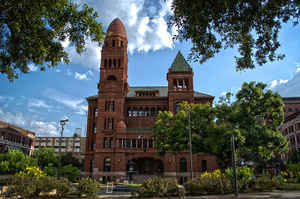Texas Counties
Texas is divided into two hundred and fifty-four counties, more than any other state. Texas was originally divided into municipalities, a unit of local government under Spanish and Mexican rule. When the Republic of Texas gained its independence in 1836, there were 23 municipalities, which became the original Texas counties. Many of these would later be divided into new counties. The most recent county to be created was Kenedy County in 1921. The most recent county to be organized was Loving County in 1931Bexar County, Texas
Bexar County Education, Geography, and History

Bexar County is a county in the state of Texas. Based on the 2010 census, the population was 1,714,773, and a 2013 estimate put the
population at 1,817,610. It is the 17th-most populous county in the nation and the fourth-most populated in Texas. Its county seat is San
Antonio, the second-most populous city in Texas and the seventh-largest city in the United States.
Bexar County is included in the San Antonio-New Braunfels, TX Metropolitan Statistical Area.
Etymology - Origin of Bexar County Name
San Antonio de Béjar, the capital of Mexican Texas and present-day San Antonio, Texas, in turn named for Saint Anthony and the Duke of Béjar, brother of the Spanish viceroy, who had died in 1686 defending Budapest from the Ottoman Empire
Demographics:
County QuickFacts: CensusBureau Quick Facts
Bexar County History
Bexar County was created on December 20, 1836, and encompassed almost the entire western portion of the Republic of
Texas. Its county seat is San Antonio. This included the disputed areas of western New Mexico northward to Wyoming. After statehood, 128
counties were carved out of its area.
The county was named for San Antonio de Bexar, one of the 23 Mexican municipalities (administrative divisions) of Texas at the time of its
independence. San Antonio de Bexar—originally Villa de San Fernando de Bexar—was the first civil government established by the Spanish in the
province of Texas. Specifically, the municipality was created in 1731 when 55 Canary Islanders settled near the system of missions that had
been established around the source of the San Antonio River. The new settlement was named after the Presidio San Antonio de Bejar, the Spanish
military outpost that protected the missions. The presidio, located at the San Pedro Springs, was founded in 1718 and named for Viceroy
Balthasar Manuel de Zuniga y Guzman Sotomayor y Sarmiento, second son of the Duke of Bejar (a town in Spain). The modern City of San Antonio
in the state of Texas also derived its name from San Antonio de Bejar.
Handbook of Texas Online
The newly formed Bexar County covered much of the western edge of settlement in Texas. During the late Mexican
period, Texas had been divided into four departments, with the department of Bexar stretching from the Rio
Grande to the Panhandle and as far west as El Paso. With the winning of
Texas independence, the departments became counties, and on December 20, 1836, Bexar County was established,
with San Antonio as county seat. Since 1860, when the partitioning of Bexar County began, 128 counties have been
carved from the original county, leaving the present county at 1,248 square miles. More at
Christopher Long, "BEXAR COUNTY," Handbook of Texas Online (http://www.tshaonline.org/handbook/online/articles/hcb07),
accessed January 23, 2016. Uploaded on June 12, 2010. Modified on January 22, 2016. Published by the Texas State Historical Association.
Geography: Land and Water
As reported by the Census Bureau, the county has a total area of 1,257 square miles (3,255 km2), of which, 1,247 square miles (3,229 km2) of it is land and 10 square miles (25 km2) of it (0.78%) is water.
Bexar County is located in south-central Texas, about 190 miles (305 km) west of Houston and 140 miles (225 km)
inland from the Gulf of Mexico.
The Balcones Escarpment bisects the county from west to northeast; to the north of the escarpment are the rocky
hills, springs and canyons of the Texas Hill Country. South of the escarpment are Blackland Prairie and the South
Texas plains. The San Antonio River rises from springs north of downtown San Antonio, and flows southward and
southeastward through the county.
Neighboring Counties
Bordering counties are as follows:
- Kendall County (north)
- Comal County (north)
- Guadalupe County (northeast)
- Wilson County (southeast)
- Atascosa County (south)
- Medina County (west)
- Bandera County (northwest)
Education







